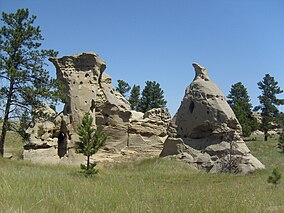Medicine Rocks State Park
| Medicine Rocks State Park | |
|---|---|
|
IUCN category V (protected landscape/seascape)
|
|

Medicine Rocks State Park
|
|
| Location | Carter County, Montana, U.S. |
| Nearest city | Ekalaka, Montana |
| Coordinates | 46°02′40″N 104°28′17″W / 46.04444°N 104.47139°WCoordinates: 46°02′40″N 104°28′17″W / 46.04444°N 104.47139°W |
| Area | 330 acres (130 ha) |
| Established | 1957 |
| Governing body | Montana Department of Fish, Wildlife and Parks |
Medicine Rocks State Park is a park owned by the state of Montana in the United States. It is located about 25 miles (40 km) west-southwest of Baker, Montana, and 11 miles (18 km) north of Ekalaka, Montana. The park is named for the "Medicine Rocks," a series of sandstone pillars similar to hoodoos some 60 to 80 feet (18 to 24 m) high with eerie undulations, holes, and tunnels in them. The rocks contain numerous examples of Native American rock art, and are considered a sacred holy place by Plains Indians. The park is 330 acres (130 ha) in size and 3,379 feet (1,030 m) in elevation. It is managed by the Montana Department of Fish, Wildlife and Parks. Theodore Roosevelt said Medicine Rocks was "as fantastically beautiful a place as I have ever seen". The park was listed on the National Register of Historic Places in 2017.
Medicine Rocks is part of the Fort Union Formation, a geologic unit containing coal, sandstone, and shale in Montana, Wyoming, and other adjacent states. About 61 million years ago, near the start of the Paleocene Epoch and during the late Zuñi sequence, a freshwater river crossed what is now eastern Montana, flowing southeast into a prehistoric sea whose boundary was near far northwestern South Dakota (possibly the remains of the Western Interior Seaway). This river deposited large amounts of very fine-grained sand, which compacted into sandstone. On top of the freshwater sandstone was sand laid down by a saltwater estuary (indicated by the presence in this greyish layer of sandstone of burrows created by marine worms). Numerous fossils dating back 63.3 million years (to the Torrejonian North American Stage) can be found at the site, which help date the sandstone. These include several fossil snakes as well as teeth belonging to Plesiadapis anceps (an early primate-like mammal). The fossil remains of the primitive mammal Baiotomeus were discovered here in 1935.
...
Wikipedia
